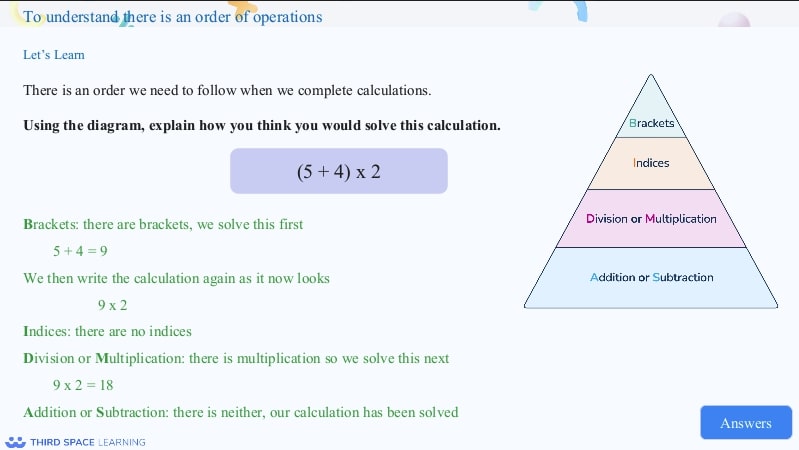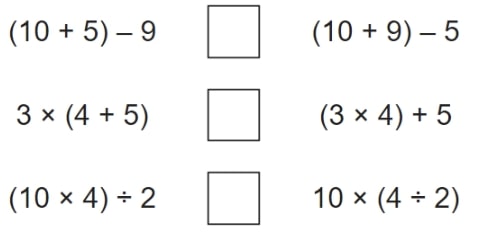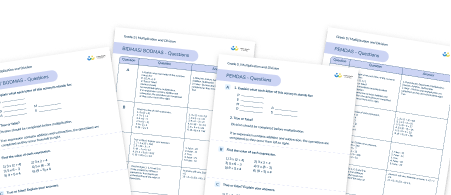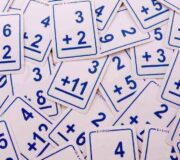What Is Order Of Operations: Explained For Elementary School
The order of operations is also known as PEMDAS, PEDMAS, BODMAS or BEDMAS, (to name a few!). It isn’t taught until 5th grade at elementary school.
- What is the order of operations
- The order of operations: PEMDAS examples
- When do children learn about order of operations in the Common Core Curriculum
- How does order of operations relate to other areas of math
- Order of operations in real life math problems
- 3 worked examples for order of operations
- 5 order of operations practice questions and answers
What is the order of operations
The order of operations is the order in which the four mathematical operations (addition, subtraction, multiplication or division) should be completed when there is more than one in a mathematical expression or equation. There are a variety of acronyms to help remember the correct order; but the most common is PEMDAS (also known by the mnemonic ‘Please Excuse My Dear Aunt Sally’)
- Parentheses
- Exponents
- Multiplication and Division
- Addition and Subtraction
The first is parentheses, which includes the grouping symbols ( ) and [ ] – known as brackets. The second is exponents, which is any term with a power. For the last four terms (‘DMAS’), it is perhaps more useful to think of it as ‘division and multiplication’ than ‘addition and subtraction’. This is because the two operations in each pair are equally weighted – it doesn’t matter which you calculate first as the answer will be the same either way.
For example, let’s take the following expression: 15 – 3 x 2 + 4. Following the order of operations, we’d start with multiplication 3 x 2 = 6. We are therefore left with 15 – 6 + 4. Because addition and subtraction are weighted equally, the remaining operations can be done from left to right: 15 – 6 is 9 and 9 + 4 = 13.
BIDMAS/BODMAS/PEMDAS Worksheet
Printable worksheet, with 14 BODMAS and BIDMAS (or PEMDAS) questions and answers for your grade 5 students.
Download Free Now!Multiplication and division are solved from left to right
Let’s take the example of 5 x 6 ÷ 3. We complete the multiplication first (5 x 6 = 30), and then the division (30 ÷ 3 = 10).
Addition and subtraction are solved from left to right
Let’s take the example 15 – 6 + 4. We do the subtraction first (15 – 6 = 9) and then the addition (9 + 4 = 13). This is the correct order of operations. Notice that solving in a different order, addition first (6 + 4 = 10) and then subtraction (15 – 10 = 5) creates an incorrect answer. Always follow the right order.
The order of operations: PEMDAS examples
Solve 14 – 2 x 6 + 5 = 7 (as per the order of operations). A common misconception would be to calculate this number sentence from left to right, which would get the incorrect answer of 77.
Third Space Learning’s AI math tutoring lessons walk students through example questions giving them a step by step breakdown of how to tackle a question before the student tries one themselves. This ‘I do, we do, you do’ approach helps to build student understanding, skills and confidence in math.

When do children learn about order of operations in the Common Core Curriculum
The Common Core math curriculum doesn’t require schools to teach this until 5th grade, where “Use parentheses, brackets, or braces in numerical expressions, and evaluate expressions with these symbols.” Students continue to build on this knowledge in 6th grade, where they learn to divide fractions, to use decimal algorithms for all operations and how to calculate with whole number exponents. In 7th grade it is expanded again to include operations with negative numbers.

Meet Skye, the voice-based AI tutor making math success possible for every student.
Built by teachers and math experts, Skye uses the same pedagogy, curriculum and lesson structure as our traditional tutoring.
But, with more flexibility and a low cost, schools can scale online math tutoring to support every student who needs it.
Find out moreHow does order of operations relate to other areas of math
In the Expressions and Equations strand in 6th grade, students apply order of operations to expressions and equations with variables as they learn to “Reason about and solve one-variable equations and inequalities.”
Order of operations in real life math problems
When having to solve multi-step mathematical problems in real life, the order of operations will often be relevant. For example, buying tickets online for $12 each with a $3 charge for online transactions would require the multiplication to be calculated first ($12 x number of tickets) and the addition after (adding $3 to the final amount).
3 worked examples for order of operations
- 5^ {2} x (9 – 7)
As per the order of operations, we complete what is inside the parentheses first (9 – 7 = 2), then exponents ( 5^ {2} = 25), then multiplication (25 x 2), so the correct answer is 50. - Write the missing number to complete the calculation: 5 + 2 x 3 – __ = 6
As per the order of operations, complete the multiplication first. 2 x 3 = 6, so we are left with 5 + 6 – __ = 6. Addition/subtraction are next, which leaves 11 – __ = 6, so the missing number is 5. Without using the order operations (so completing the calculation from left to right), you would get the wrong answer of 15 (5 + 2 = 7, then 7 x 3 = 21, leaving 21 – __ = 6).
- By placing one pair of parentheses in this number sentence, how many different answers can you make? 4 + 5 x 2 – 1
- Putting the parentheses round the whole number sentence, the first three numbers [(4 + 5 x 2) – 1], the last three numbers [(4 + (5 x 2 – 1)] or the multiplication alone [4 + (5 x 2) – 1] gives the same answer as if there were no parentheses at all (the answer being 13).
- (4 + 5) x 2 – 1 = 17 [Completing the parentheses first: 4 + 5 = 9; then the multiplication: 9 x 2 = 18; then the subtraction: 18 – 1 = 17]
- 4 + 5 x (2 – 1) = 9 [Completing the parentheses first: 2 – 1 = 1; then the multiplication: 5 x 1 = 5; then the addition: 4 + 5 = 9]
So there are three different answers depending on where the pair of parentheses is placed: 13, 17 or 9.
5 order of operations practice questions and answers
Challenge your students’ problem solving skills with these PEMDAS questions:
1) Write the missing numbers to make these calculations correct.
a. 200 x ___ – 200 = 200
b. (100 – ___) x 100 = 100
Answer: a) 2 b) 99
2) 60 – 24 ÷ 6 =
Answer: 56
3) Write the >, < or = in each of the boxes below to make the statements correct.

Answer: <, >, =
4) Write what the missing numbers could be: 120 = 100 + (__ – __)
Answer: Any two numbers with a difference of 20, e.g. 40 and 20, or 31 and 11 etc.
5) 900 ÷ (45 × 4) =
Answer: 5
READ MORE: 7th Grade Math Problems
The steps are the order of operations, which are: Parentheses, exponents, multiplication and division, addition and subtraction. Note that some equations will not require all steps. For example, step 1 in the expression 5 + (6 – 4) is addition – skipping the steps of parenthese, exponents and multiplication and division.
They are both correct – they are just different acronyms for the same thing. PEMDAS stands for parentheses, exponents, division and multiplication, addition and subtraction. BODMAS stands for brackets, orders, division and multiplication, addition and subtraction.
Do you have students who need extra support in math?
Skye—our AI math tutor built by experienced teachers—provides students with personalized one-on-one, spoken instruction that helps them master concepts, close skill gaps, and gain confidence.
Since 2013, we’ve delivered over 2 million hours of math lessons to more than 170,000 students, guiding them toward higher math achievement.
Discover how our AI math tutoring can boost student success, or see how our math programs can support your school’s goals:
– 3rd grade tutoring
– 4th grade tutoring
– 5th grade tutoring
– 6th grade tutoring
– 7th grade tutoring
– 8th grade tutoring
The content in this article was originally written by primary school teacher Sophie Bartlett and has since been revised and adapted for US schools by elementary and middle school teacher Kathleen Epperson.







